| This plant has many descriptive common names, and also can be called accurately by more than one scientific name. Lumpers may --like myself above, and D.J. Mabberley in his Plant Book-- use Thevetia peruviana. On the other hand, splitters may opt for Cascabela Thevetia as does the online Plant List. It boils down to accepting either one genus Thevetia with two subgenera, or two separate yet very closely related genera. |
| In either case, English common names include: Yellow Oleander. Mexican Oleander. Be-Still Tree. Lucky Bean. Lucky Nut. Exile Tree. Tiger Apple. Suicide Tree. Milk Bush. French Willow. Yellow Trumpet-flower. Rattle Tree. Tiger Apple. Captain Cook Tree. Here are a few names in Spanish: Yoyote. Rosa Amarilla. Flor del Peru. Cascabel. |
| It is a subtropical shrub or small tree to some 30 feet tall, native to Mexico and the Caribbean, south to Bolivia and Paraguay. It is much cultivated and naturalized in various tropical regions around the world. |
| I knew nothing about it, yet because it has been sparingly cited as being used as a houseplant, and I am researching edible houseplants, I needed to learn about it. Very quickly, one finds that it is a poisonous plant. |
| Cerbera Thevetia was an early name given by Linneaus from Cerberus (a three-headed watch-dog of hell, whose bite was poison), on account of its poisonous properties. The generic name Thevetia honors André de Thévet (1516 - 1590) a well known French Franciscan priest, explorer, Royal cosmographer and colorful writer, of mixed repute. |
| The species was cultivated in England by 1735; in the U.S. before 1800; in India by 1801. It is prized for its elegant, shiny foliage, yellow, sweetly fragrant flowers; and its adaptability: it can be a clipped hedge, a shrub, or a tree, and is grown easily on relatively dry sites such as sandy beaches. Also it grows well in pots. Its hard nut-like seeds were hollowed, polished, and used by the people of pre-Columbian Peru for rattles, and are still so used today for ankle bracelets, or as pendants and good luck charms. This usage accounts for the generic name Cascabela, referring to rattling or little bells. Its copious white milky sap has been used to seal envelopes in Nicaragua. |
| Elvin McDonald, in his 1993 book The New Houseplant, writes that it is easily grown from seed to blooming in two seasons. Ingrid Jantra and Ursula Kruger in their 1997 book The Houseplant Encyclopedia advise: never let the plant go below 59 degrees F (15 C); water little in summer, hardly at all in winter. All sources agree it needs well-drained soil. |
| The name Be-Still tree, from Hawaii, alludes to the way "the slightest breeze will set in motion the large, slender shining green leaves" [When You Go To Hawaii You Will Need This Guide To The Islands by Townsend Griffiths 1930]. It is called Mexican or Yellow Oleander because 1) it is in the same family as Common Oleander (Nerium Oleander L.), and 2) in 1841 it had been named Thevetia neriifolia meaning the Thevetia with Oleander-like foliage. |
| Its leaves are slender, to about 6 or 7 inches long and barely over half an inch wide. To me, they suggest more the leaves of Podocarpus macrophyllus than Oleander. They are dark, shiny green, inodorous, and ooze white sap if broken. But the sap can cause dermatitis and the leaves are poisonous. During much of the year, showy flowers are borne. They are trumpet shaped, 2 - 3 inches long, contain nectar, and are variously yellow, peach colored, or rarely white. They give rise to oddly shaped seedpods. |
| The 4-angled seedpods, or fruits, have been likened in shape to hickory nuts, bell peppers, and turnips. They vary in size but reach at most about 1.75 inches wide. They begin green, but ripen to reddish, and finally shrink and dry to almost black. Each has 2 or 4 large seeds enclosed in the scanty pulp. |
The plant is so toxic that apparently the only parts of it that are ever ingested safely are the fruit pulp, and maybe its floral nectar. Because the plant is so widely known to be toxic, I here share some reports (chronologically) on the fruit pulp's edibility:
|
Louis Evan Grivetti, Agricultural Development: Present and Potential Role of Edible Wild Plants Part II Sub-Saharan Africa 1980, quoting Woody Plants of Ghana with Special Reference to their Uses by F. R. Irvine 1961: fruit.
|
Plants for Human Consumption 1984 by Günther Kunkel: black pulp of fruit eaten but plants poisonous.
|
H.M. Burkill, ed. 2nd ed. Useful Plants of West Tropical Africa 1985: "The foliage is not grazed by stock. In Indonesia it is reported used as a fish-poison. The fruits have shown some insecticidal activity, and especially the kernels. All parts of the plant are poisonous. It has been used in southern Africa as an arrow or ordeal-poison. A number of glycosidal derivatives of cardenolide have been detected of which thevetin is present throughout except in the leaves and fruit-pulp. The kernel contains another and more toxic bitter principle which causes tetanic convulsions and speedy death for which it is commonly used in India for suicide and murder. There is in the kernel a pale yellow fixed oil amounting to 57 - 62%. Raw, of course, it is poisonous, and is used in external application in India to areas of skin-infections. [used as a purgative and emetic] It can be freed of the toxic principles and is then fit for culinary purposes. The fruit pulp is sometimes eaten in Ghana without any apparent ill-effect."
|
Encyclopedia of Fruit Trees and Edible Flowering Plants in Egypt and the Subtropics 2000 by Alfred G. and Warda H. Bircher: Exile oil in India sometimes used for cooking.
|
J. Francisco Morales, in three papers in Darwinia (43(1 - 4) 2005; 44(2) 2006; 47(1) 2009), writes that in different areas of Mesoamerica, the pulp of the ripe, almost dry fruit is eaten by birds and occasionally humans, but the seeds, which are sold to use for weight loss, are toxic and can cause death.
|
Handbook of Wild Edible Plants [of Himachal Pradesh] by S.K. Sood et al. 2012: also mentions fruit.
|
| Despite the preceding, I have neither tasted the fruit pulp, nor do I intend to. If I had to, moreover, I would do so in the afternoon or evening. Why? Robert Carroll, et al., wrote "Diurnal variation in probability of death following self-poisoning in Sri Lanka --evidence for chronotoxicity in humans" in International Journal of Epidemiology 41(6) (2012): Between March 2002 & December 2009, over 5,500 records of self-poisoning were checked involving ingestion of yellow oleander (C. thevetia) seeds. There was increased case fatality after morning ingestions and decreased case fatality after ingestions in the afternoon and evening. Patients who ingested seeds in the late morning were over twice as likely to die than people who ingested seeds between 16:00 and 24:00. |
| Presumably, any toxins that may be in the fruit pulp would be processed similarly to those in the seeds. It is the crushed seeds that are used to commit suicide in south India. They also have been used as abortifacients, and to kill rats, termites, aphids and whatnot. Since they are so high in oil (up to 67 per cent) their "Exile Oil" has been used for biofuel, as a light source, for industry and soap making. The plant also is used in medicine. Named toxins called cardiac glycosides include thevetin A and B, cerebrin, neriifolin; and cardioactive steroids thevetoxin and peruvoside, producing symptoms similar to those of Digitalis: nausea, vomiting, irregular pulse, and death. These toxins not destroyed by drying or heating. |
Bottom line, despite the many virtues, this species is sufficiently dangerous that it ought not be used as a houseplant where pets or children may come into contact with it. For more information I suggest: A review on: Thevetia peruviana by Singh Kishan et al. in International Research Journal of Pharmacy 2012 3(4), that has much information on both the plant's toxicity and its therapeutic roles. [Incidentally, a second sepcies, Thevetia Ahouai (L.) A.DC., also has varied sources confirming that its ripe fruit pulp is edible.]
Back |
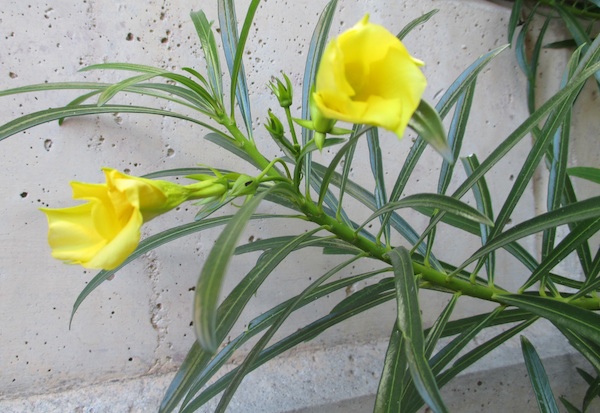
Thevetia flowers; photo by ALJ
|
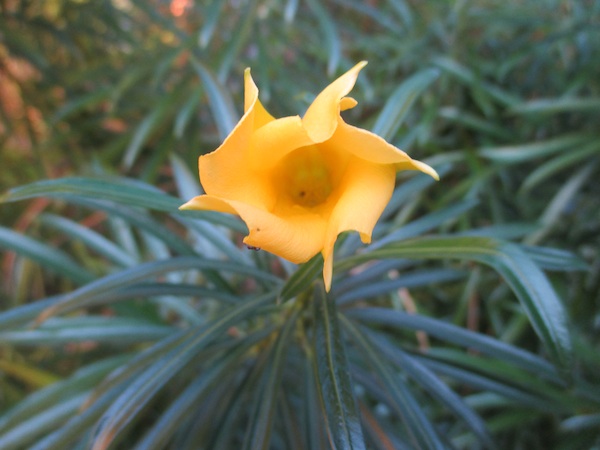
Thevetia flower; photo by ALJ
|
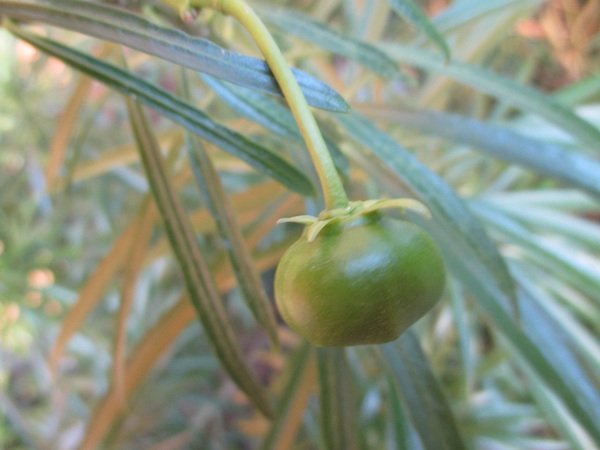
Thevetia unripe fruit; photo by ALJ
|
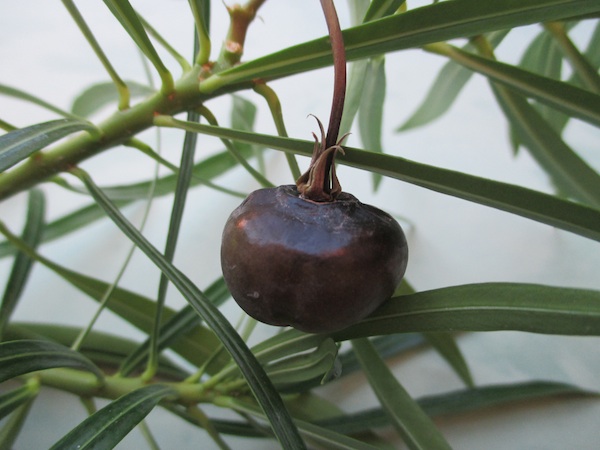
Thevetia ripe fruit; photo by ALJ
|
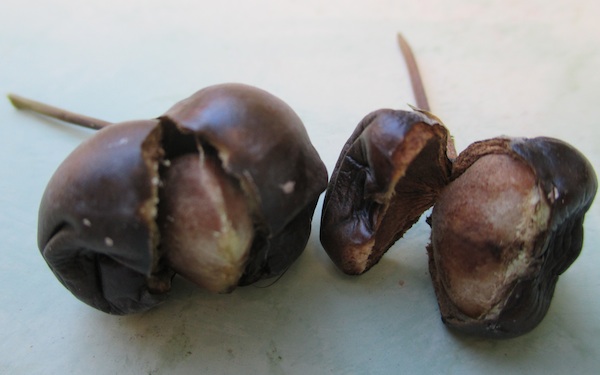
Thevetia ripe fruits & seeds; photo by ALJ
|

